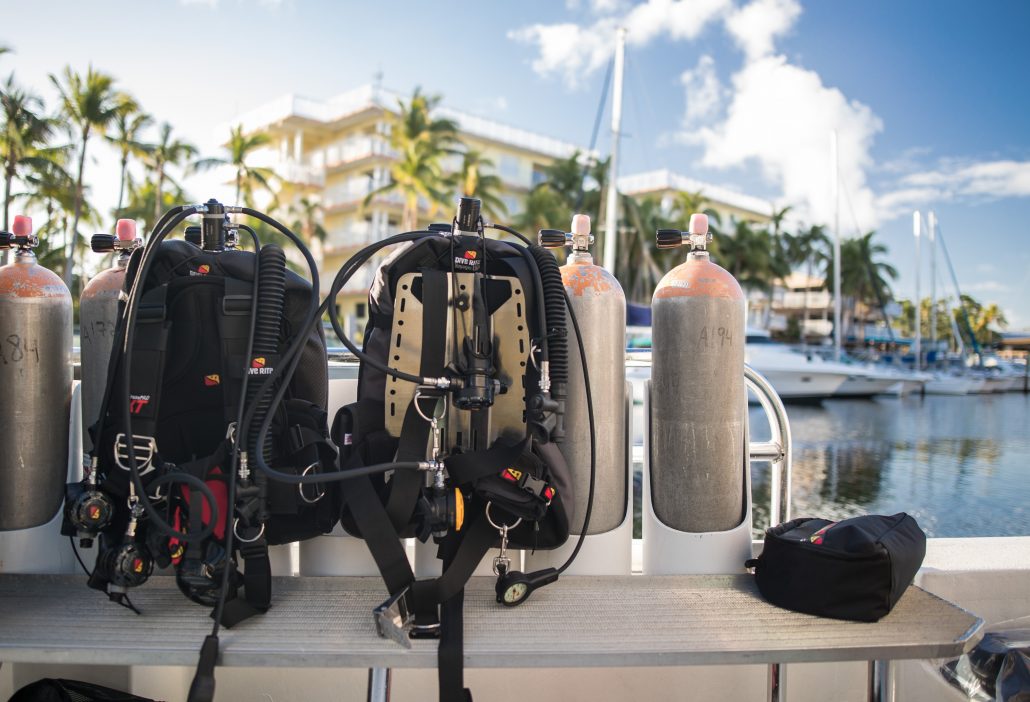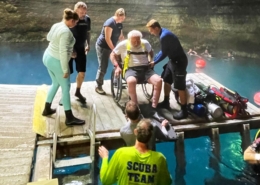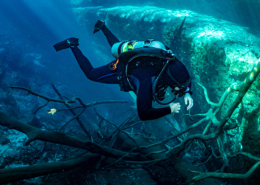Can you teach Open Water in backplate, harness and wing?
By Mark Powell
Short answer – Yes
Longer answer – Yes, of course you can.
What, you want more of an explanation?
OK, well SDI has always allowed the use of a range of equipment when teaching Open Water. The standards specify say a single-tank backmount setup, but do not specify the style of BCD or harness. It is perfectly acceptable and within the standards to use a backplate, harness and wing as well as using a long hose.
The SDI training materials have always discussed the use of jacket style and wing style BCDs and have also included long hose configurations. We wouldn’t include them in the training materials if we didn’t allow you to use them.
There are a number of reasons why teaching in a backplate, harness and wing (BPHW) is becoming more popular. In this article I will focus on the use of the BPHW configuration in open water and leave discussion of a long hose setup for another article.
It looks cool
One superficial but important reason is that it looks cool and divers like cool kits. Now this might seem unimportant, but when scuba diving is competing with other ‘cool’ sports like mountain biking and stand-up paddle boarding, anything we can do to make the sport seem cooler is a good idea. It helps attract people into the sport, which is good for the whole industry.
Adjustability and Modularity
The adjustability and modularity of the BPHW setup is a huge advantage for the diver. Rather than having a configuration that is limited in its application, the diver has a setup that will grow with them. They can add weight pockets when needed, switch between different backplate materials and weights for different diving conditions, and change the harness when it becomes worn. For divers looking to buy something that will grow with them at an affordable price, this is very attractive.
From the teaching point of view, the BPHW configuration makes it easier for the student to achieve good trim. This can speed up the learning process and make the student feel more comfortable and confident in their initial dives. A more comfortable and confident diver is more likely to continue with diving and stay with the sport when compared to a diver that struggles and loses confidence.
Benefits for the dive center
For the dive centre, the use of a BPHW configuration has very real financial benefits. The standard jacket style BCD must be the right size of the student. That means that the dive centre has to carry a full range of sizes from XS to XXL. The majority of these will not be in use at the same time, which is a lot of investment in inventory that has a relatively low utilization. A typical dive centre may have 20 BCDs in stock in order to run a course with 4-6 students. A benefit of the BPHW configuration is that the harness is almost infinitely adjustable. That means that the same harness can be adjusted from an XS up to a M or XXL relatively easily. As a result, the dive centre does not need to carry such a wide range of BCDs. Stocking 10 BHW configurations rather than 20 jacket style BCDs is an obvious benefit in terms of initial outlay, maintenance and depreciation.
Many dive centres are now switching over their school kits to BPHW for all the reasons above.
It is clear there are some real advantages to the student, the instructor, the dive centre and the industry in using a BPHW configuration. Despite this, the question of whether you can teach using BPHW keeps coming up. I regularly have instructor, Course Director or Instructor Trainer candidates that, despite the fact they normally dive in a single cylinder BPHW set up, turn up for their course in a borrowed BCD setup because they think that is what is required.
In addition, the same set of arguments as to why you cannot teach in a BPHW configuration and the same set of perceived problems keep coming up in-person and, of course, online. Let’s put those arguments and problems to rest once and for all.
Standard kit
The most common argument is that in courses we must use “standard” or “normal” kit and that a BCD is standard. This is an interesting argument as it hasn’t always been like that, and BCDs were not always considered “normal.”
Early divers had no form of buoyancy control device at all and would change depth by swimming up or down. The first commercially available buoyancy control device was the Adjustable Buoyancy Life Jacket (ABLJ). These were developed from standard Life jackets and early models were orally inflated with later models having small emergency cylinders and then direct free connections. The “jacket style” BCD we use now was only invented in the early 1970s only came into popular use in the 1980s.
If we had always stuck to standard kit, then we would not have progressed from no BCD to ABLJ and then on from an ABLJ to a jacket style BCD.
In fact, BCDs were controversial when they were first introduced. Many people considered BCDs to be dangerous as they were not a true lifejacket and, unlike an ABLJ, would not float you up when unconscious. Despite these concerns and the fact that they were not “normal” or “standard” jacket style, BCDs were almost universally adopted because of their advantages over ABLJs.
The use of equipment evolved from ABLJs to BCDs. However, there is nothing special or unique about BCDs that means no further change is possible. Dive gear evolves and changes. Just as BCDs were adopted as the best available technology at the time, there is no reason other technology cannot be adopted. The BCD itself has evolved with the use of integrated weights rather than a separate weight belt. If a BPHW configuration has advantages over a BCD configuration, then there is no reason why it should not be adopted.
The whole argument that you can only ever use “normal” or “standard” kit is actually dangerous, as it means that we can never progress. If something comes along that is better than the current normal or standard kit, then we should be adopting it. If a BPHW is a better solution than the current standard configuration, then we should be changing what we consider to be a standard kit.
They will need to be familiar with a BCD as that is what they will come across when they travel.
The argument is that they need to be familiar with the BCD configuration as they may only have access to a BCD if they use a rental kit. In addition, they may have buddies with a BCD style jacket. These are all valid points and I agree that divers should be introduced to jacket-style BCDs even if they learn on a BPHW configuration. However, the same argument applies in reverse. Divers that learn in a BCD need to be familiar with a BPHW set up in case they are buddies with a diver in this configuration. As BPHW becomes more and more popular, this is becoming more of an issue.
So open water courses should cover the use of both BCD and BPHW.
Of course, it is impractical to teach all skills in both configurations, but a good solution would be to explain both in the equipment configuration section. Then, get the diver to perform all the skills in one configuration. It would be sensible to show a diver in a BPHW configuration how to do a buddy check on a diver in a BCD, but it also makes sense to show divers in a BCD how to do a buddy check on a diver in a BPHW configuration. After their open water course, if a diver switches from a BCD to BPHW (or vice versa) they will just need a familiarization session with an instructor and they are ready to go diving in their new configuration.
Instructors should use the same kit as the student
There is a lot of validity to this argument. It makes a lot of sense for instructor and student to be in the same kit. It makes it easier for the instructor to demonstrate skills if the equipment matches. This can be solved easily enough. Put both the student and the instructor in BPHW and problem solved. If the instructor normally dives in a BPHW and genuinely believes this is the best option, then why wouldn’t they want to give their student an advantage by starting off in that configuration? “Do what you teach and teach what you do” is a powerful mantra. This is a perfect example of it.
It also looks odd to a student when the instructor insists on them using a jacket style BCD and may even sell them that same configuration but then uses a BPHW configuration for their own diving.
How can you teach a particular skill in the required way if using BPHW?
This argument is a result of the mentality that there is only one way to teach a skill. The skills in some agency’s courses were codified when jacket style BCDs were common. This means that the steps make perfect sense when using a jacket style configuration but may not make sense in another configuration. Some instructors take this to mean that if you cannot follow the standard process then you need to change the equipment so that you can follow the process. However, this is the wrong way around, it is not a question of changing the equipment to match the skill but changing the skill to match the equipment. If the ‘standard’ technique for regulator recovery doesn’t work for BPHW, then change the technique. The goal is not to follow a defined set of steps but to achieve an end result. The standard set of steps might achieve the desired end result in a BCD setup, but if it doesn’t work for a BPHW set up, then we need to change the set of steps in order to achieve the desired goal.
Some skills need to be taught in a slightly different way but overall, they are minor changes.
Buddy check/Review the ABCDEs – obviously if the diver is using a BPHW configuration, the buddy check needs to cover this. For a buddy pair where they are both in BPHW, the process is identical. In reality, there are less differences between BPHW and a typical jacket style BCD than between many different styles of jacket-style BCD. For a mixed buddy pair, where one is wearing a BPHW and the other is wearing a jacket-style BCD, the buddy check just needs to ensure that each person is familiar with their buddies’ equipment and knows how to remove it in the case of an accident. The key differences between a BPHW and BCD style jacket are:
- A – Air – no change
- B – Buoyancy
- Less buckles and clips. Often the only release is the waist strap on the harness.
- Not all wings have a shoulder pull dump, check whether it does and if so, is it working
- More focus on the kidney dump and checking that it is working
- C – Computer – no change
- D – Diving gear
- If in a one-piece harness, where is the cutting device if it is necessary to cut the harness.
- E – Enter – no change
BCD Inflate and Deflate – The only difference in teaching this skill is that there is slightly more focus on using the rear kidney dump rather than just using the shoulder dump. This is because the diver is more likely to be in a flat, horizontal trim position and in this case the rear kidney dump may be more effective than the shoulder dump. The student should practice reaching and finding the rear kidney dump before using it to dump air. The student should also be aware of when to use the shoulder dump and when to use the rear kidney dump and should practice using both. You could argue that if we are encouraging diver to be in a flat trim position, then all open water divers, whether using a BPHW or BCD configuration, should be able to do this. I would not disagree with you.
BCD Remove and Replace – It is often possible to complete this skill in the ‘standard’ way by sliding the left arm out of the harness strap and swinging the whole scuba unit assembly around to your right side. However, if the harness is a one-piece harness and it is not possible to loosen the shoulder straps then this might be a challenge. You can use the “chicken wing” technique by folding your arm in and sliding it through the harness and then sliding the assembly around to the right. An alternative technique is to reach over your head, grasp the cylinder or valve behind your head and pull the whole scuba unit assembly up and over your head.
When performing this skill on the surface, the alternative technique of pulling the scuba assembly over your head is not recommended and the better option is to use the chicken wing option.
Remove and Replace Weight System – Many BPHW configurations come with integrated weights or they can be easily added, in which case, this skill is no different to how it is taught when using integrated weights in a BCD. Equally, if the diver is using a weight but no crotch strap, then there is no difference to how it is taught with a BCD.
The key difference comes when the diver is using a weight belt combined with a crotch strap. It is not practical for the diver to wear the weight belt over the crotch strap. There is an argument that wearing it under the crotch strap has a safety advantage in the case of the weight belt falling off. It will be caught by the crotch strap and the diver will not lose it. On the other hand, if a diver wants to dump their weight belt and releases it, without first releasing the waist strap and crotch strap, then the weight belt will catch on the crotch strap and will not fall free. When teaching this skill, the process will depend on the exact configuration. Here are a few options:
Option 1 – Crotch strap with quick release
- Release the crotch strap quick release
- Release the weight belt
- Check that the weight belt has not been fouled
Option 2 – Crotch strap looped onto waist strap
- Release the harness waist strap
- Ensure the crotch strap comes free of the waist strap
- Release the weight belt
- Check that the weight belt has not been fouled
When replacing the weight system, the reverse process is followed. It is important to make sure the crotch strap is out of the way before replacing the weight belt. There is no doubt that replacing a weight belt under water while using a crotch strap does make things more complicated. The key points to stress to the student:
- Get your buddies help rather than struggling.
- It is not essential to be able to replace the crotch strap underwater, as long as the weight belt is secure you can ascend and resolve the problem on the surface.
As you can see, there are many advantages to using a BPHW and any disadvantages can easily be managed. With this sort of configuration becoming more popular, there will be more and more demand for instructors to teach in this manner. As we have seen in this article, there is no reason why the instructor and the student should not be wearing a BPHW configuration in the open water class. Equally, there is no reason why the instructor and student should not be wearing BPHW in a Rescue, Dive Master, Instructor, Course Director or Instructor Trainer course.













Oh absolutely you can teach! it actually makes it so much easier! Maybe the long hose adds a bit of confusion, but ppl can learn that too, not that complicated. 🙂